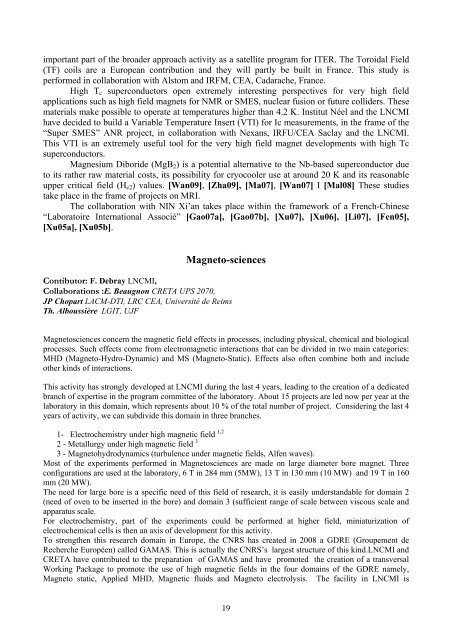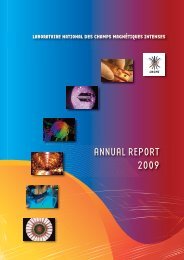Laboratoire National des Champs Magnétiques Pulsés CNRS – INSA
Laboratoire National des Champs Magnétiques Pulsés CNRS – INSA
Laboratoire National des Champs Magnétiques Pulsés CNRS – INSA
Create successful ePaper yourself
Turn your PDF publications into a flip-book with our unique Google optimized e-Paper software.
important part of the broader approach activity as a satellite program for ITER. The Toroidal Field<br />
(TF) coils are a European contribution and they will partly be built in France. This study is<br />
performed in collaboration with Alstom and IRFM, CEA, Cadarache, France.<br />
High Tc superconductors open extremely interesting perspectives for very high field<br />
applications such as high field magnets for NMR or SMES, nuclear fusion or future colliders. These<br />
materials make possible to operate at temperatures higher than 4.2 K. Institut Néel and the LNCMI<br />
have decided to build a Variable Temperature Insert (VTI) for Ic measurements, in the frame of the<br />
“Super SMES” ANR project, in collaboration with Nexans, IRFU/CEA Saclay and the LNCMI.<br />
This VTI is an extremely useful tool for the very high field magnet developments with high Tc<br />
superconductors.<br />
Magnesium Diboride (MgB2) is a potential alternative to the Nb-based superconductor due<br />
to its rather raw material costs, its possibility for cryocooler use at around 20 K and its reasonable<br />
upper critical field (Hc2) values. [Wan09], [Zha09], [Ma07], [Wan07] I [Mal08] These studies<br />
take place in the frame of projects on MRI.<br />
The collaboration with NIN Xi’an takes place within the framework of a French-Chinese<br />
“<strong>Laboratoire</strong> International Associé” [Gao07a], [Gao07b], [Xu07], [Xu06], [Li07], [Fen05],<br />
[Xu05a], [Xu05b].<br />
Magneto-sciences<br />
Contibutor: F. Debray LNCMI,<br />
Collaborations :E. Beaugnon CRETA UPS 2070,<br />
JP Chopart LACM-DTI, LRC CEA, Université de Reims<br />
Th. Alboussière LGIT, UJF<br />
Magnetosciences concern the magnetic field effects in processes, including physical, chemical and biological<br />
processes. Such effects come from electromagnetic interactions that can be divided in two main categories:<br />
MHD (Magneto-Hydro-Dynamic) and MS (Magneto-Static). Effects also often combine both and include<br />
other kinds of interactions.<br />
This activity has strongly developed at LNCMI during the last 4 years, leading to the creation of a dedicated<br />
branch of expertise in the program committee of the laboratory. About 15 projects are led now per year at the<br />
laboratory in this domain, which represents about 10 % of the total number of project. Considering the last 4<br />
years of activity, we can subdivide this domain in three branches.<br />
1- Electrochemistry under high magnetic field 1,2<br />
2 - Metallurgy under high magnetic field 3<br />
3 - Magnetohydrodynamics (turbulence under magnetic fields, Alfen waves).<br />
Most of the experiments performed in Magnetosciences are made on large diameter bore magnet. Three<br />
configurations are used at the laboratory, 6 T in 284 mm (5MW), 13 T in 130 mm (10 MW) and 19 T in 160<br />
mm (20 MW).<br />
The need for large bore is a specific need of this field of research, it is easily understandable for domain 2<br />
(need of oven to be inserted in the bore) and domain 3 (sufficient range of scale between viscous scale and<br />
apparatus scale.<br />
For electrochemistry, part of the experiments could be performed at higher field, miniaturization of<br />
electrochemical cells is then an axis of development for this activity.<br />
To strengthen this research domain in Europe, the <strong>CNRS</strong> has created in 2008 a GDRE (Groupement de<br />
Recherche Européen) called GAMAS. This is actually the <strong>CNRS</strong>’s largest structure of this kind.LNCMI and<br />
CRETA have contributed to the preparation of GAMAS and have promoted the creation of a transversal<br />
Working Package to promote the use of high magnetic fields in the four domains of the GDRE namely,<br />
Magneto static, Applied MHD, Magnetic fluids and Magneto electrolysis. The facility in LNCMI is<br />
19







